Carbitool Beginners Guide to Wood Working – Top 5 products
16.08.2023

The world of woodworking encompasses a diverse range of disciplines from “knocking up” bush furniture to the modern practice of cross-laminated timber replacing steel in the superstructures of large buildings. Wood working evokes different recollections for different people depending on our own unique experiences. From back sheds to professional joineries, practices can be as simple or advanced as is required for the job at hand. Woodworking is a craft that’s as diverse as it is captivating.
So, if you’re an absolute beginner, don’t be intimidated. There’s bound to be a woodworking activity that is suitable for you and will give you a lot of enjoyment.
But what exactly is woodworking and how do you go about getting started?
Understanding woodworking
At its core, woodworking is the craft of shaping & joining wood into both beautiful and/or useful creations.
Consider cabinets, tables, instruments, bowls and even those decorative Cheeseboards. These are all born from the hands of skilled artisans.
These artisans use techniques like carving, joinery (fitting pieces of wood together), and
woodturning (creating rounded shapes using a wood lathe) to bring their creations to life. These methods have
been honed over generations and showcase a legacy of hands-on expertise.
If you’re new to the world of woodworking, don’t be discouraged by the initial challenges.
It’s like embarking on a new adventure. With the right tools in your toolbox, what may appear as
an intimidating undertaking can become a satisfying and enjoyable endeavour.
So let’s dive in and demystify woodworking one step at a time!
Step 1. Build your beginner toolkit
No matter your skill level, having essential tools is a must. Take for example, our Carbitool Budget Kit
A 12-piece router bit set – tailored for those who enjoy DIY projects. The cutters in this kit incorporate an anti-grab or anti-kickback design which helps prevent the cutter ‘grabbing’ or ‘jamming’ in the workpiece. It’s basically a rounded shoulder on the router bit body which limits the chip size of the material you’re cutting and makes working with high-speed cutting tools a lot safer.
Inside this kit you’ll find all the necessary bits to begin routing at a handyman/DIY level.
Imagine an everyday person transforming into a woodworking pro. TBUD-12 includes 12 useful commonly used router bits and is a comprehensive selection enabling you to dive right in and get started with confidence.
.
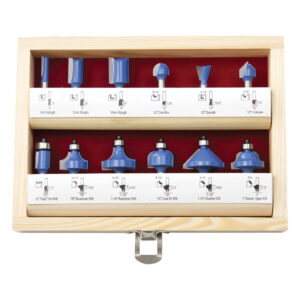
Step 2. Obtain the right size wood
Saws play a significant role in woodworking. There’s a variety of saws and
techniques used for different projects. The main purpose of using a saw is to cut wood to
the correct size. Often the required size timber for your project isn’t available off the shelf so a saw becomes a crucial tool to cut the wood to your specific dimensions.
For those new to woodworking, the S12 Tenon Saw is a must-have in your toolkit. It’s heat-treated teeth maintain their sharpness for up to 6 times longer than regular saw teeth. These are a well balanced, easy to handle saw offering a fine and accurate cut.
Or why not upgrade to a traditional style, premium quality Lynx Brand Tenon Saw or Handsaw manufactured in Sheffield by E. Garlick & Son. The blades are made from superior quality Alloy Steel with the Tenon Saw having a 3″ deep blade with brass back while the Handsaws blades are taper ground with a skew back giving effortless cutting and good balance. Both feature either a beech or Rosewood handle.
Carbitool also offer a fully comprehensive range of Tungsten Carbide Tipped Circular Saw Blades for both portable and bench machines.
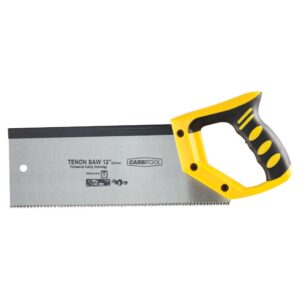
Step 3. Remember the glue!
Using glue to bond pieces of wood together can sometimes create a join more robust than regular nails. Maximizing the surface area contact by shaping each component using joining cutters then applying Carbitool PVA wood glue will ensure success. It’s available in handy sized 250ml & 500ml bottles – PVA250 & PVA500
Clamps can be a handy addition to your workshop for holding the timber components in place while the glue dries.
For beginners and the experienced alike, our Carbitool Bar Clamp & Spreader CL150 is a fantastic tool to have in your toolkit. It has a quick-release handle with 150mm clamping capacity and a vice like grip. It’s a versatile tool with a 165-350mm spreading capacity making it an ideal choice.
If you’re looking for an extremely flexible multipurpose clamp, try the Carbitool Adjustable Clamp CL180 It’s a great general purpose clamp with 7 jaw angles with a capacity range up to 180mm.
Clamps simplify work holding. Whether it’s for securing your workpiece while adhesives dry or as a fastening mechanism for machining materials, your job will be easier, safer and you’ll achieve better results using reliable clamps.
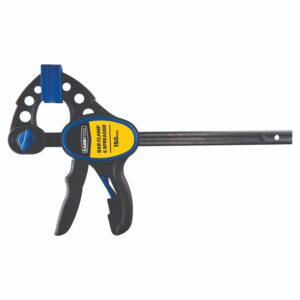
Step 4. Craft strong woodworking joints
When you’re working on a new project, you want it to come together seamlessly. The myriad of joining cutters in our router bit range will ensure there’s one to suit your application. From Finger Joint Bits, Tongue & Groove Bits, Drawer Joint Bits, Mitre Lock Bits, Panel Door Bits, Window Sash & Rail Bits to Dovetail Bits, there’s bound to be a joining cutter that’ll maximize the joint strength of your job.
A mortice & tenon joint can also be cut with a router bit. A simple straight bit will do this effectively but because they’re a rotary cutting tool, you’ll be left with a radius of uncut timber in the corner of the mortice or slot.
That’s where the Carbitool Corner Chisel comes into play – it is a compact yet powerful “L – shaped” carbon steel chisel housed in an aluminium assembly which locates easily in the corner of a routed slot allowing corners to be “squared up” with a gentle tap from a hammer.
Imagine you’ve routed out the rebate in the back of a picture frame so you can fit a larger artwork than the original rebate was intended to hold. Using the Corner Chisel for “squaring up” the corners of the rebate will be a quick and easy way to complete the job.
.
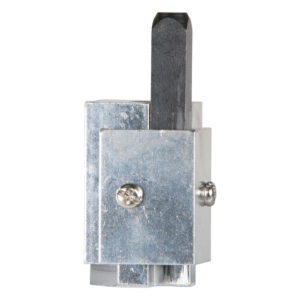
Step 5. Perfect your piece
While all these tools are crucial in woodworking, there’s one process that truly elevates your
work from amateur to professional, and that’s sanding.
Sanding involves using abrasive paper to smooth the wood’s surface. Coarse grit sandpaper will remove material faster but will leave a rougher finish whereas finer grit sandpaper will remove material more slowly but will achieve a smoother finish for a polished look. The process can be sped up using an electric sander. These are available in a range of formats – 1/3 sheet sanders, orbital sanders, detail sanders, belt sanders, linishers etc. Drum sanders are a particularly useful tool which allow a high degree of control when sanding.
Carbitool offer a handy 25 piece Drum Sanding Kit which contains shank mounted rubber cylinders that support the abrasive sleeves These can be used in a pedestal drill or a hand held power drill. The Carbitool Drum Sanding Set DSK-25 includes 5 rubber-backed drums ranging in size from ½” to 2” in diameter, 2 x 80 grit sanding sleeves to suit each drum size (10 pieces) and 2 x 120 grit sanding sleeves to suit each drum size (10 pieces). The sanding sleeves are available as a spare part if you need a “refill” – 80 Grit (10 Pcs) DSKR80 &120 Grit (10 Pcs) DSKR120. This set will ensure your final creation emerges smooth and flawless.
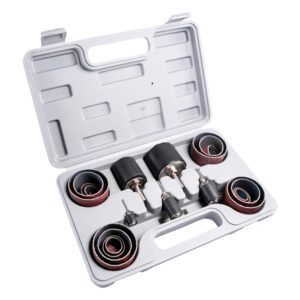
Whether you’re a seasoned craftsman or a curious newcomer, Carbitool is your ally in
woodworking. With four decades of manufacturing expertise and a commitment to ongoing product development and quality improvement, we understand the importance of nurturing creativity and encouraging a high level of craftsmanship in the woodworking community.
Don’t let woodworking feel daunting. With the right tools it can become a joyful journey. So whether you’re just starting out or aiming to enhance your skills, Carbitool offers an array of timber tools and accessories for every project.
Explore our complete product range online or reach out to us at sales@carbitool.com.au for
more information.
Here’s to happy woodworking! 🙂
